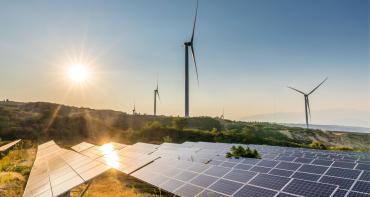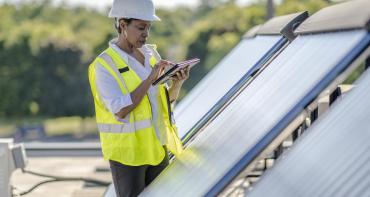Blog by Dr Ruth Kattumuri, Unnikrishnan Nair, Labanya Jena and Alexander Lee-Emery

The new Loss and Damage Fund (LDF) agreed at COP27 represents a long and hard-fought win for small and vulnerable states and an important step towards climate justice. Loss and damage, in its broadest definition, encompasses all the negative impacts of climate change including extreme weather events like hurricanes and flooding, and slow onset events like rising temperatures and ocean acidification.
Since Vanuatu and the Association of Small Island States (AOSIS) first called for an international insurance pool for sea level rise in 1991, loss and damage issues gained momentum within the UNFCCC dialogue and subsequent COPs. The main benefactors are expected to be small island developing states (SIDS) and particularly climate-vulnerable countries. The concept of vulnerability as a measure to allocate funding has been gaining traction, with the UN High Level Panel on Multidimensional Vulnerability Index and the Commonwealth Universal Vulnerability Index at the forefront of this development.
Loss and damage
The agreement with LDF has been achieved following another year of climate crises involving extreme weather events, including extreme flooding in Pakistan, Bangladesh, China, and Australia, multiyear droughts in Kenya and East Africa, extreme heat waves in Europe and India, Hurricane Ian in the USA, and Hurricane Fiona in the Caribbean and Canada. The severe impacts of climate change are becoming more frequent, more intense, causing more damage and loss of lives. Therefore, greater resources are required to respond and rebuild.

Since 1991, an average of 189 million people in developing countries have been affected by extreme weather events each year, and 29 climate disasters were recorded in 2022, with loss and damage estimated at over USD 1 billion. Annual global economic output could be eroded by 4% by 2050 due to climate change, more so in poorer countries.
The new LDF presents an opportunity to help vulnerable developing countries respond to climate change impacts and build resilience. The effectiveness of LDF will be determined by the efficiency of raising adequate capital and the development of adequate mechanisms to respond rapidly and meet the urgent needs of Vulnerable, and Low- and Middle-Income Countries (LMICs) suffering losses and damage.
As the impacts of the climate crisis accelerate, vulnerable countries need immediate access to funds to address their losses and damage. This warrants the LDF to be set up and operationalised as quickly as possible. Although the details of the LDF are still to be decided, a transitional committee is expected to meet before the end of March 2023. This committee will make recommendations at COP28 aimed at operationalisation of LDF by the end of 2023.
The rapidity and agility of disbursing LDF is key to helping a country recover from its shock due to losses and damages resulting from climate disasters. It had taken four years for the Green Climate Fund (GCF) to raise the first round of funding after it was established. GCF still takes multiple years to make a decision on providing financial support to a project, which can be constraining.
It is hoped that the LDF will disburse capital rapidly without having to go through a cumbersome process. Without agility in disbursing funds to countries going through climate shocks, LDF will lose its relevance.
Climate finance commitments
Vulnerable countries are already apprehensive about the lack of a clear distinction between development finance and climate finance, when it had been clearly stated that climate finance commitments were additional. Multilateral development financing provided by international finance institutions (IFIs) is mainly for projects or programs. Hence, most of the financial support is in the form of concessional debt capital.
The purpose of LDF is to provide financial support immediately and not involving onerous processes. It is expected that the LDF could be similar to that of an insurance company underwriting a parametric insurance product and paying policyholders immediately after an unexpected shock evaluated according to the intensity of the event and based on a checklist of eligible criteria.
Belgium (US$2.5m), Austria (US$52m over four years), New Zealand (US$12m to 2025), Germany (US$177m), Canada (US$6.2m), Ireland (US$10.4m), Scotland (US$2.2m), and Denmark (US$13.7) have already pledged funds for Loss and Damage. For example, Canada has dedicated US$5.25 million to loss and damage by supporting the work of the Global Shield with an additional US$0.94 million for the Santiago Network from its US$18 million climate spending dedicated to the needs and priorities of developing countries.

New Zealand has committed US$12 million to loss and damage from climate change to support Pacific priorities. Belgium has initiated the provision of US$2.5 million in loss and damage funding for Mozambique to protect their communities and environment against natural disasters from its commitment to Mozambique as part of a seven-year package of US$26 million. The money is expected to provide the climate-vulnerable East African nation with storm warning systems and advanced intel on at-risk coastal areas.
These commitments provide a good start. However, the scale of losses from climate-induced weather events are immense. Hence the size of LDF should be adequate to assist vulnerable countries to recover and rebuild after climate shocks and necessitates support from governments and IFIs to be commensurate with the needs.
Fit for purpose
There is also a need to define the scope of LDF and distinguish it from existing humanitarian and disaster management funds that might resemble loss and damage support. The percentage of losses and damages covered by the LDF have to be according to risk coverage to be determined. Too low-risk coverage will not serve the purpose of LDF, while a very high or blanket coverage could disincentivise investment in climate adaptation.
To ensure LDF will be fit for purpose, clear governance structures and processes are required to enable efficient disbursement and deployment. In particular, clear guidelines are required to assess the extent of loss and damage and concurrence on value and processes for utilisation. For example, Vanuatu has already initiated valuation through their First Nationally Determined Contribution Plan 2021-2030, including a loss and damage programme adding up to around $178 million.
Further, consistency and fairness in applying valuation methodologies between countries, and a common guidance must be issued. The value of loss and damage should also consider the cost of rebuilding assets instead of the cost incurred by building assets. Moreover, there are non-monetary losses (e.g., loss of life) associated with extreme weather events or biodiversity loss, therefore these considerations should be incorporated in determining the criteria.
Formulation of LDF must ensure wide stakeholder consultation between climate vulnerable and LMIC and potential donors. Once the processes have been established, there is a need for knowledge-sharing and capacity building programmes to enable access and ensure that pledges can be distributed efficiently and implemented where they are most needed.
Commonwealth Climate Finance Access Hub
The Commonwealth Climate Finance Access Hub (CCFAH), which embeds Commonwealth National Climate Finance Advisers within relevant government offices is an initiative to support member countries access global climate finance, particularly for Small Island Developing States (SIDS) and LMICs. CCFAH can work in collaboration with LDF to support training and capacity building to support Commonwealth member states affected by loss and damage to access essential funds.

The Loss and Damage Fund has great potential to alleviate the severe shocks due to climate change in vulnerable countries. LDF is an essential aspect for climate justice and helps to address the geographic imbalance between the cause and effect of climate crisis. The development of LDF also presents an opportunity to apply best practices and streamline access and distribution right from the design phase.
While the Loss and Damage Fund agreed at COP27 is a key milestone in progressing with addressing the challenges of climate change, global commitments for emission reduction target of 1.5 degrees has to be kept alive. Without scaling efforts to address the root cause of climate change, the costs of loss and damage over time will become untenable for all countries.
Enhancing resilience, responding rapidly to disasters, facilitating green growth, and delivering just energy transitions need to be advanced to prevent the colossal damages due to climate change increasing exponentially year on year and protect our people and our planet.
Media contact
- Josephine Latu-Sanft Senior Communications Officer, Communications Division, Commonwealth Secretariat
- +44 20 7747 6476 | E-mail



